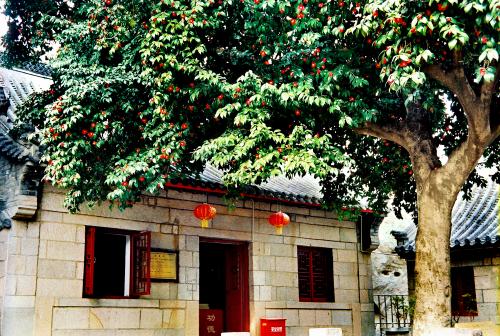绛雪

绛雪
中文名:山茶
拉丁名:Camelia japonica L.
别名:耐冬 山茶科、茶属
位置:太清宫三皇殿
树龄:410年
树高:10米
胸围:140厘米
冠幅:平均105米
太清宫内的植物最著名的是山茶树,共有五六株。山茶树是亚热带树种,主要生长在云南,花期从每年的11月分开到来年的5月份,长达半年,又正值隆冬和春寒怒放,它能在北方的青岛生长,青岛人很是荣耀,把它称为“耐冬树”,把山茶花评为“市花”。此树是明代著名道士张三丰从附近的长门岩岛上移植而来。每到隆冬时节,这株山茶千花怒放,整个树冠就像落上了一层厚厚的红雪,又称“绛雪”。清代著名文学家蒲松龄来到此地,看到此景,灵感油然而生,写下了脍炙人口的聊斋故事《香玉》,文中的花神“绛雪”便是这株山茶花的化身。
Chinese name: Camellia
Latin name: Camelia japonica L.
Alias: Rose of winter Theaceae Family and Genus Camellia
Location: Three-Emperor Temple of Taiqing Palace
Tree-age: 410 years old
Tree height: 10 m
Tree circumference: 140 cm
Crown spread: 105 m on average
The Camellia trees are the most famous plants in Taiqing Palace. There are five or six camellia trees here. Camellias are subtropical and mainly grow in Yunan Province. Their blossom lasts for about half a year from December to May, in midwinter and cold spring, and it is able to grow in the northern city of Qingdao. This makes the people of Qingdao feel great pride, and they call it the “rose of winter” and flower of Qingdao City. It is said that it was transplanted by Zhang Sanefeng from “Changmenyan Island”, a small island in the Yellow Sea. Every midwinter, this camellia tree blossoms with thousands of flowers, just like a blanket of “red snow” falling onto the tree crown. When Pu Songling, the writer of Strange Stories from a Chinese Studio, came to Taiqing Palace, he saw this, was inspired and wrote Xiangyu, a very popular story in Strange Stories from a Chinese Studio. The “Jiangxue” Flower God in the story is the incarnation of this camellia.
강설(絳雪)
중국어 이름:동백나무
라틴어 학명:Camelia japonica L.
별칭:동백나무 동백나무과、동백속
위치:태청궁삼황전
나이:410년
높이:10미터
지름:140센티미터
나무 꼭대기 폭:평균105미터
태청궁에서는 가장 유명한 식물은 동백나무이며 총 5,6그루가 있습니다. 동백나무는 아열대 나무입니다. 주로 운남성(雲南省)에 자라고, 꽃이 피는 시기는 매년 11월부터 다음 해의 5월로 6개월동안 핍니다. 꽃이 피는 시기는 한겨울이나 이른 봄이지만, 꽃이 활짝 피고 북방의 청도에서 자라기 때문에 청도사람들은 이를 자랑스러워 합니다. 청도 사람들은 이를 내동(耐冬)이라 부르고, 동백나무를 청도시(青島市)를 대표하는 꽃으로 선정합니다. 명나라 때의 도인 장삼봉(張三丰)이 ‘장문암도(長門岩島)’에서 이 동백나무를 옮겨 심었습니다. 한겨울이 될 때마다 이 동백나무는 붉은 꽃을 활짝 피우기 때문에 ‘붉은 눈’이 붙어 있다고 하여, ‘강설(絳雪, 붉은 색 눈의 뜻이다)’ 이라고 부르기도 합니다. 청나라 때 저명한 작가 포송령(蒲松齡)이 이곳에 왔을 때, 이 경치를 보고 영감이 저절로 떠올랐다고 합니다. 그는 인구에 회자하는 요재 고사(聊齋故事) <향옥(香玉)>을 썼고, 그 글의 꽃 실령 ‘강설(絳雪, 붉은 색 눈의 뜻이다)’은 바로 이 동백나무의 화신입니다.
深紅の雪(しんくのゆき)
和名:ツバキ
ラテン名:Camelia japonica L.
别名:冬耐 ツバキ科、ツバキ属
位置:太清宮三皇殿
樹齢:410年
樹高:10m
幹周:140cm
枝張:平均105m
太清宮内にある植物の中で最も有名なものはツバキの木で、全部で5、6本あります。ツバキは亜熱帯樹木の種類で,主に雲南地区に生息し、花期は11月から翌5月まで、半年間開花し、ちょうど厳冬と春寒(はるさむ)の時期に満開になります。ツバキは北方の青島でも生息でき、青島人はこれを光栄なものとし、「耐冬(たいとう)の木」と称し、ツバキを「市の花」に選びました。この木は明朝の有名な道士張三豊が近くの長門岩島から移植してきたものです。厳冬時期になると、このツバキには数千の花が満開となり,全体に一層の厚い深紅の雪が落ちたように見えることから「深紅の雪」と呼ばれています。清朝有名な文学者蒲松齢はここに来た際、この景色からひらめきを得て、有名な聊齋の物語「香玉」を書きました。作中の花の神「深紅の雪」はこのツバキの化身となっています。


 景区热线:0532-96616
景区热线:0532-96616

